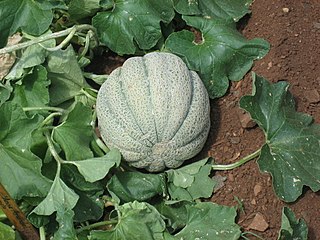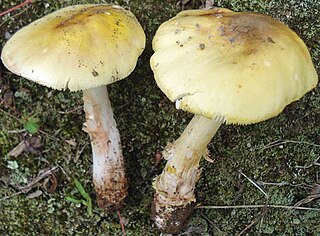
The cantaloupe is a type of true melon with sweet, aromatic, and usually orange flesh. Originally, cantaloupe refers to the true cantaloupe or European cantaloupe with non- to slightly netted and often ribbed rind. Today, it also refers to the muskmelon with strongly netted rind, which is called cantaloupe in North America, rockmelon in Australia and New Zealand, and spanspek in Southern Africa. Cantaloupes range in mass from 0.5 to 5 kilograms.

A melon is any of various plants of the family Cucurbitaceae with sweet, edible, and fleshy fruit. The word "melon" can refer to either the plant or specifically to the fruit. Botanically, a melon is a kind of berry, specifically a "pepo". The word melon derives from Latin melopepo, which is the latinization of the Greek μηλοπέπων (mēlopepōn), meaning "melon", itself a compound of μῆλον (mēlon), "apple", treefruit " and πέπων (pepōn), amongst others "a kind of gourd or melon". Many different cultivars have been produced, particularly of cantaloupes.

Momordica charantia is a tropical and subtropical vine of the family Cucurbitaceae, widely grown in Asia, Africa, and the Caribbean for its edible fruit. Its many varieties differ substantially in the shape and bitterness of the fruit.
The Bailan melon is a locally famous melon grown near Lanzhou, the capital city of Gansu province in the People's Republic of China. It is a variety of honeydew melon, globose to subglobose and typically has white skin with sweet, white or pale green, flesh. In photographs, the melons appear light yellow, orange or white, with a light green or apricot yellow flesh, which makes it similar in appearance to other types in the cultivar group of true melon. It is also heavy due to the density of the fruit's inner flesh. Like other types of honeydews, the Bailan melon is rich in Vitamin C and protein.
Canary originally referred to the island of Gran Canaria, in Spain, and the group of surrounding islands. It may also refer to:

The honeydew melon is one of the two main cultivar types in Cucumis melo Inodorus Group. It is characterized by the smooth, often green or yellowish rind and lack of musky odor. The other main type in the Inodorus Group is the wrinkle-rind casaba melon.

The Hami melon is an umbrella term for sweet melon varieties from Xinjiang, China, especially from Hami. It is also referred to as the Chinese Hami melon or the snow melon. The outer color is generally white through pink or yellow through green. The inside flesh is sweet and crisp.

In optics, orange has a wavelength between approximately 585 and 620 nm and a hue of 30° in HSV color space. In the RGB color space it is a secondary color numerically halfway between gamma-compressed red and yellow, as can be seen in the RGB color wheel. The complementary color of orange is azure. Orange pigments are largely in the ochre or cadmium families, and absorb mostly blue light.

The Santa Claus melon, sometimes known as Christmas melon or Piel de Sapo, is a variety of melon originating in Spain that grows to about a foot in length and is ovoid in shape. It has a thick, green-striped outer rind and pale green to white inner flesh with a mild melon flavour and sweetness close to honeydew melons.

Varieties of the color red may differ in hue, chroma, lightness, or in two or three of these qualities. Variations in value are also called tints and shades, a tint being a red or other hue mixed with white, a shade being mixed with black. A large selection of these various colors are shown below.

Amanita persicina, commonly known as the peach-colored fly agaric, is a basidiomycete fungus of the genus Amanita with a peach-colored center. Until c. 2015, the fungus was believed to be a variety of A. muscaria.

Watermelon is a flowering plant species of the Cucurbitaceae family and the name of its edible fruit. A scrambling and trailing vine-like plant, it is a highly cultivated fruit worldwide, with more than 1,000 varieties.

Cucumis melo, also known as melon, is a species of Cucumis that has been developed into many cultivated varieties. The fruit is a pepo. The flesh is either sweet or bland, with or without an aroma, and the rind can be smooth, ribbed, wrinkled, or netted. The species is sometimes referred to as muskmelon, but there is no consensus about the usage of this term, as it can also be used as a specific name for the musky netted-rind American cantaloupe, or as a generic name for any sweet-flesh variety such the inodorous smooth-rind honeydew melon.

Amanita flavorubens, also known as the yellow American blusher or the yellow American blushing amanita, is a species of fungus in the family Amanitaceae.

The Gaya melon, also known as the ivory gaya, snowball, sweet snowball, ghost, dino(saur), dino(saur) egg, snow leopard, matice, matisse, sugar baby, and silver star melons, is a small to medium-sized honeydew cultivar developed originally in Japan and Korea and now grown in China, Mexico, southern California, and South America.

The kolkhoznitsa melon, also known as the collective farm woman melon, is a melon in the genus Cucumis native to Russia and introduced to the United States in 1993.
The Kajari melon, also known as the Delhi melon, is a honeydew cultivar originating in Punjab grown for its unique coloring.
The Mirza melon, also known as the torpedo melon, Mirzachul melon, or gulabi melon, is a cultivar of sweet melon in the genus Cucumis native to Uzbekistan and Central Asia and introduced to California.
Kinkoji unshiu is a Citrus hybrid cultivated for its edible fruit.













